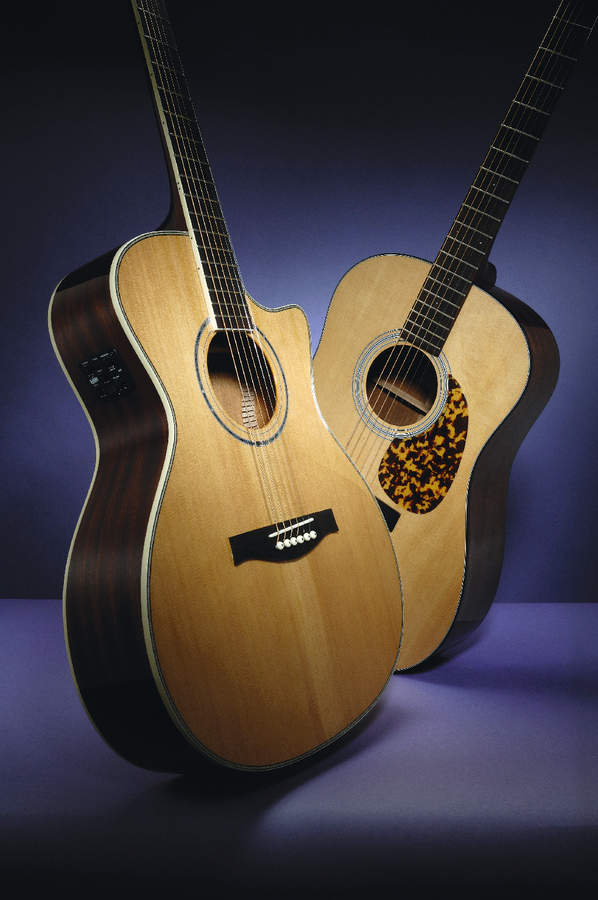MusicRadar Verdict
This classy dread stands out visually and tonally in a saturated market.
Pros
- +
The authentic old-school vibe and classic tone.
Cons
- -
Only the gaudy pickguard.
MusicRadar's got your back
The dismantling of the Berlin Wall in 1989 wasn't just a social victory - it was also a starting pistol for the wheels of industry.
By the following year, the German designer Toni Goetz and the Czech luthier Frantisek Furch had met, bonded over a shared admiration for the work of Slovakian design legend John Dopyera, agreed on the traditionalist ethos of their fledgling business and launched the original Stanford Artist series from a workshop in the Czech Republic.
You won't find many people with a bad word to say about the models that have arrived in the UK since the early-nineties, but if there is a factor that has kept Stanford Guitars as cult heroes rather than ubiquitous overachievers, it could be that the product line has always been quite expensive, with the Artist series spanning from £800 to a cool £1,500.
But no longer: in 2007, out of nowhere and almost simultaneously, Stanford unveiled two new Chinese-made lines - the mid-price Performer and entry-level Monterey - meaning that this intriguing brand is suddenly vying for the wallet of the everyday punter.
Overview
In a market that is both saturated, yet starved of imagination, a little bit of design flair can go a long way. It's a lesson that has been heeded by Stanford with the PSRD10 - unquestionably the most interesting member of the four-strong Chinese-built Performer series.
Rather than trace the outlines of the square-shoulder Martin D-28 (the basis of the overwhelming majority of mid-priced dreadnoughts), Stanford has sought inspiration from the Gibson acoustics of the thirties, and turned in a slope-shoulder model whose visual clout could lift the most jaded strummer out of his torpor.
There are physical, tonal and psychological implications of the slope-shouldered design - and we'll get to those later. The most immediate factor is that the PSRD10 looks superb, exuding an old-world charm and backing this up with quality timbers.
Supported by scalloped internal bracing, both the Sitka spruce of the expansive top and the mahogany of the bruising body are solid, and while you'd probably expect that for £459, not all models at this price point have such tidy graining and neat binding. Based on this example, the Chinese production line has already hit its stride.
When it comes to hardware the PSRD10 scores again, with vintage tuners finding and holding pitch, fretwire finished with care and a 45mm bone nut cementing the good impression.
The trimmings are as unfussy as the foundations - the mother-of-pearl inlays and low-key rosette are subtle enough to miss, and it's a shame that can't be said for the pickguard, which has a slightly unwelcome 'Lily Savage' vibe.
Despite the supple shoulders, the PSRD10 is physically big, as it should be, clocking in with a rim depth of 125mm and measuring 402mm at its most voluptuous. Somewhat unusually for a mid-priced guitar, we get a full 45mm wide bone nut here which will please fingerstylists no end.
This sits perhaps slightly at odds with slope-shoulder dread's strummy, singer-songwriter heritage (Gibson's J-45 has a slimmer 43.8mm). Whatever the numbers, there's plenty of space to get stuck into expressive sliding runs and vibrato-heavy single notes, helped with a manageable neck profile and a good fret job.
Sounds
If you've been hunting for classic unamplified dreadnought tone on a budget, it might be time to call off the search. Given the dimensions, build and timbers, it's inevitable that the PSRD10 has plenty of raw welly. Yet what stops us in our tracks is the quality of that welly.
While Martin-style acoustics tend to lean towards clarity and response, the operative word when it comes to a decent slope-shouldered dreadnought is balance, and we certainly got that here with the PSRD10 supplying a beautifully clear mid-range, a thumpy bass and a mellow top end that together build a tone that commands attention and will only get better as the woods bed in.
Of course, in this day and age not everyone will want to pay £459 for a natural acoustic - and the lack of a piezo-equipped Performer is an oversight - but we'd suggest the tone of this model is worth the hassle of either adding a soundhole pickup or mic'ing in a stage or studio context.
“Built from the same sacred stash of NOS silicon transistors and germanium diodes, giving it the soul – and snarl – of the original”: An octave-fuzz cult classic returns as Jam Pedals resurrects the Octaurus
What’s the buzz? Meet Yellowjacket, Cherry Audio's recreation of EDP’s trend-setting Wasp from 1978
“A fabulous trip through all eight songs by 24 wonderful artists and remixers... way beyond anything I could have hoped for”: Robert Smith announces new Cure remix album










